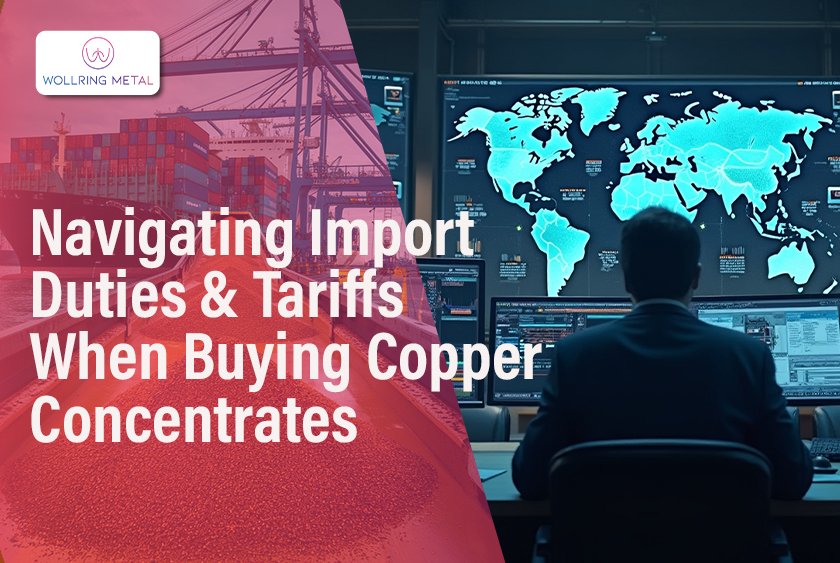Navigating Import Duties & Tariffs When Buying Copper Concentrates
When Costs Aren’t What They Seem: The Hidden Complexity Behind Copper Imports
In 2023, a mid-sized European trading company signed a copper concentrate supply agreement with a European exporter. Everything seemed aligned—logistics, quality, documentation. Yet, weeks later, their shipment sat at port, stalled by unforeseen customs complications and ambiguous tariff clauses. Penalties mounted, delivery timelines collapsed, and client confidence began to erode.
What caused the chaos? A single misinterpretation of import duties and customs regulations.
This is not a rare event. It’s a story echoed across international trading floors—and often, the real price of copper concentrate isn’t just in dollars per metric ton, but in how well the buyer navigates the regulatory minefield.
Let’s explore how to avoid such risks and master the mechanics behind copper concentrate import duties, tariffs, and trade rules.
What Most Importers Get Wrong About Copper Concentrate Duties
Too many first-time and even experienced buyers assume that copper concentrate import duty is uniform across markets. In reality, it fluctuates significantly based on:
• Country of origin and import destination
• Bilateral or multilateral trade agreements
• Purity grade and moisture content of the concentrate
• Classification under local and international tariff schedules
For example, while the European Union’s import duty on copper ores and concentrates is generally zero under HS Code 2603, importing the same from a non-GSP (Generalized System of Preferences) country might expose buyers to secondary levies or handling costs.
This misunderstanding often leads to mispricing, delayed clearances, or worse—blacklisting by customs due to incorrect declarations.
Breaking Down Tariffs on Copper Concentrate
Tariffs on copper concentrate aren’t just defined by a fixed percentage rate. Instead, they span a matrix of additional levies including:
• Ad valorem taxes (percentage of value)
• Specific duties (fixed amount per ton)
• Environmental surcharges (especially in the EU and East Asia)
• Customs processing fees (often overlooked by buyers)
For instance, in China—one of the largest importers of copper concentrate—tariffs can vary based on the concentrate’s arsenic levels and may invoke environmental checks. In contrast, ASEAN countries applying regional trade agreements often reduce tariffs to encourage raw material inflow.
Therefore, assuming a flat duty can dismantle your cost calculation model before the first container even arrives.
Copper Concentrate Customs Regulations: Where Paperwork Meets Power
Copper concentrate customs regulations are anything but routine. Most customs authorities now require:
• Full chemical composition breakdown
• Radioactive element disclosure
• Certificate of Origin (CoO) aligned with HS coding
• Proof of sustainable mining practices (ESG compliance becoming critical)
• Moisture content and transit documentation
Failing to provide even one of these can trigger automatic detention, fines, or consignment rejection. Some customs departments in Europe and South America are now integrated with blockchain traceability systems, demanding precise digital compliance.
Regulations aren’t just bureaucratic; they’re a reflection of national strategy—ensuring that natural resource trade flows align with environmental and economic priorities.
Understanding the Copper Concentrate HS Code Without Getting Lost in Jargon
The globally recognized copper concentrate HS code is 26030000, falling under “Copper ores and concentrates.”
But simply tagging your consignment under this code isn’t enough. Customs authorities in Europe, Asia, and the Americas often enforce micro-classifications, such as:
• 2603.00.10 – Sulfide-based concentrates
• 2603.00.20 – Oxide-based concentrates
• 2603.00.90 – Other, including blended forms
This nuanced differentiation determines not just duties but inspection protocols, warehousing rules, and eligibility under Free Trade Agreements.
Getting the HS code wrong might trigger red flags in customs AI systems, flagging your shipment as potentially fraudulent or suspicious.
Why Import Copper Concentrate from Europe? The Rising Global Shift
Europe’s copper-rich nations—Poland, Spain, and Serbia—are now at the epicenter of global supply chains. In 2023 alone, over 3.1 million metric tons of copper concentrate were exported from European ports, with more than 45% headed toward Asian smelters.
So why do buyers import copper concentrate from Europe?
• High ore grades (often exceeding 20% Cu)
• Cost advantages from emerging market producers
• Strategic investment from China, India, and EU to boost reliability
• Flexibility in long-term offtake agreements
However, European exports come with strict port compliance protocols and documentation expectations. Miss those, and the price advantage turns into a liability.
Case Study: Two Traders, Two Outcomes
Trader A signed a lucrative deal in 2022 but failed to comply with the copper concentrate trade rules of their destination country—specifically, failing to declare trace arsenic content and inaccurately using the wrong HS code variant. Result? Their shipment was detained for 63 days. The customer withdrew, and $180,000 was lost in demurrage.
Trader B, meanwhile, followed a structured compliance model: precise HS coding, verified documentation, chemical assay verification, and proper tariff estimation. Their consignment cleared in 48 hours, with early delivery bonuses boosting client loyalty.
The lesson? Compliance isn’t a cost. It’s an investment in credibility, speed, and growth.
The Bigger Picture: Transparent Trade Rules Build Market Trust
As global scrutiny of resource trade rises, clarity and predictability are fast becoming competitive advantages.
Copper concentrate trade rules are evolving beyond just paperwork—they now include ESG metrics, carbon traceability, and digital shipping audits. Governments and trading blocs are pushing toward harmonized classification systems. Even platforms like the World Customs Organization (WCO) are piloting AI-based risk engines to assess mineral shipments.
The new age of copper trade demands adaptability. Importers must think like strategists—not just buyers.
And That’s Where a Partner Like WOLLRING METAL Makes All the Difference
With expertise rooted in transparent copper sourcing, regulatory foresight, and end-to-end compliance support, WOLLRING METAL doesn’t just supply copper concentrate—it secures trust across every transaction layer.
Their ability to simplify HS classifications, pre-calculate duties, and build Europe trade pipelines with complete traceability makes them more than just an exporter. They’re a reliable shield against customs chaos, price miscalculations, and regulatory uncertainty.
In a world where one tariff misstep can cost millions, WOLLRING METAL delivers precision where others deliver confusion.
